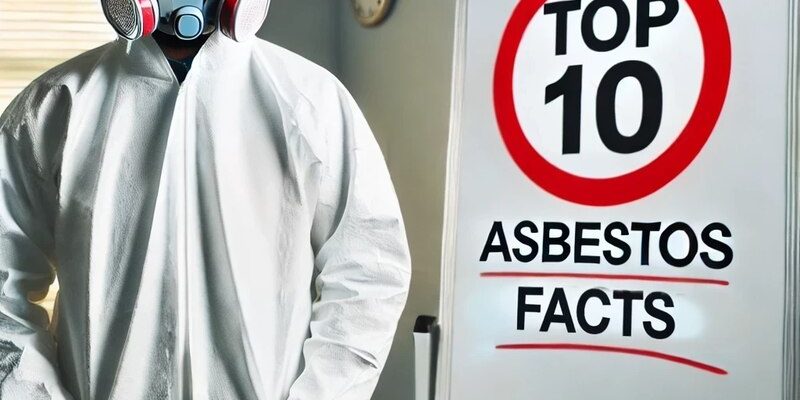Introduction
Understanding asbestos and its impact on health and safety is crucial, especially for homeowners, workers, and anyone involved in construction or renovation. Asbestos was once widely used for its fire-resistant properties, but its hazardous effects on health are now well-documented. This article covers the top 10 facts you need to know about asbestos, including its risks, where it’s commonly found, and the importance of professional asbestos surveys.
What is Asbestos?
Asbestos is a group of naturally occurring fibrous minerals known for their durability and resistance to heat, fire, and chemicals. These fibers are microscopic and can be easily inhaled, leading to serious health issues. Historically, asbestos was used in various construction materials, insulation, and fireproofing products due to these properties.
Historical Use of Asbestos
Asbestos has been used for thousands of years, dating back to ancient civilizations. However, its widespread use surged during the Industrial Revolution when its fire-resistant properties made it ideal for building ships, factories, and homes. It was commonly used in roofing, flooring, cement products, and even household items like ironing boards and toasters.
Health Risks Associated with Asbestos
Exposure to asbestos fibers can lead to severe health conditions. The primary diseases associated with asbestos exposure are:
- Asbestosis: A chronic lung disease that causes scarring of lung tissue.
- Mesothelioma: A rare and aggressive cancer affecting the lining of the lungs, abdomen, or heart.
- Lung Cancer: Increased risk for those exposed to asbestos, especially among smokers.
The symptoms of these diseases can take decades to appear, making early detection and prevention critical.
Common Places Asbestos is Found
Asbestos can be found in many older buildings and homes. Common locations include:
- Insulation: Used around pipes, boilers, and ducts.
- Flooring: Vinyl tiles and the adhesives used for installation.
- Roofing: Shingles and cement sheets.
- Walls: Plaster and drywall joint compounds.
- Automotive Parts: Brake pads and clutches.
Identifying asbestos in these materials often requires professional inspection and testing.
Importance of Asbestos Surveys
Asbestos surveys are essential for identifying and managing asbestos-containing materials (ACMs) in buildings. These surveys help to:
- Identify ACMs: Locate and assess the condition of asbestos materials.
- Assess Risks: Determine the potential risk of exposure.
- Plan Remediation: Develop strategies for safe removal or encapsulation.
Professional surveys are crucial before any renovation or demolition work to prevent accidental asbestos exposure.
Legal Requirements for Asbestos Management
Many countries have stringent regulations regarding asbestos management. In the UK, for instance, the Control of Asbestos Regulations 2012 mandates that:
- Employers must assess the risk of asbestos exposure and take appropriate measures.
- Duty holders must manage asbestos in non-domestic properties.
- Licensed contractors must carry out high-risk asbestos removal work.
Failure to comply with these regulations can result in severe penalties and health risks.
How to Identify Asbestos
Identifying asbestos in materials requires specialized knowledge and equipment. Signs that a material might contain asbestos include:
- Age: Buildings constructed before the 1980s are more likely to contain asbestos.
- Condition: Damaged or deteriorating materials may release asbestos fibers.
- Labels: Some materials may have labeling indicating asbestos content.
However, confirmation often requires sampling and laboratory analysis by certified professionals.
Safe Asbestos Removal Practices
Removing asbestos safely is critical to preventing exposure. Key practices include:
- Professional Removal: Hiring licensed asbestos removal contractors.
- Containment: Using plastic sheeting and negative air pressure to contain fibers.
- Proper Disposal: Following regulations for sealing and disposing of asbestos waste.
DIY asbestos removal is strongly discouraged due to the high risk of contamination.
Asbestos and Environmental Impact
Asbestos not only poses health risks but also environmental concerns. Improper disposal of asbestos can lead to contamination of soil and water sources. Asbestos fibers can remain in the environment for a long time, posing ongoing risks to wildlife and human populations. Thus, stringent disposal protocols are in place to mitigate these risks.
Future of Asbestos Regulations
The awareness of asbestos dangers continues to grow, leading to stricter regulations and safer alternatives. Innovations in building materials and increased regulations are helping to phase out asbestos use. Additionally, ongoing research aims to improve asbestos detection and remediation technologies, providing safer environments for future generations.
Conclusion
Staying informed about asbestos is essential for protecting your health and property. Understanding its risks, knowing where it is commonly found, and recognizing the importance of professional asbestos surveys are critical steps. By following safe practices and complying with regulations, you can mitigate the dangers associated with asbestos exposure.
Exposure to asbestos fibers can cause serious health conditions such as asbestosis, mesothelioma, and lung cancer.
Asbestos is commonly found in insulation, flooring, roofing, walls, and some household items.
Asbestos surveys help identify and manage asbestos-containing materials to prevent exposure and ensure safety during renovations or demolitions.
In the UK, the Control of Asbestos Regulations 2012 requires risk assessments, proper management, and the use of licensed contractors for asbestos removal.
Identifying asbestos requires specialised knowledge and equipment. Professional inspection and laboratory analysis are recommended.
Safe asbestos removal involves professional contractors, containment measures, and proper disposal to prevent contamination.







